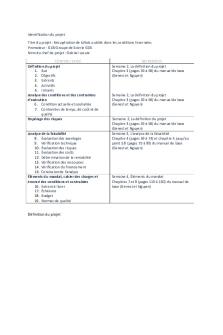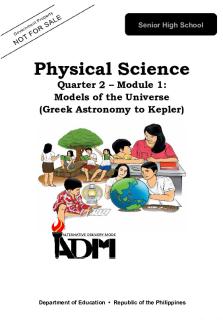Lecture 1 adm - Kerstin Forsberg PDF

| Title | Lecture 1 adm - Kerstin Forsberg |
|---|---|
| Author | Ahmed Barre |
| Course | Separationsprocesser för processindustri och miljö |
| Institution | Kungliga Tekniska Högskolan |
| Pages | 30 |
| File Size | 1.8 MB |
| File Type | |
| Total Downloads | 105 |
| Total Views | 137 |
Summary
Kerstin Forsberg...
Description
Separation Processes for the Process Industry and the Environment KE2180, 9 credits, P2 & P3, 2017/18 Kerstin Forsberg
Bure Dept. of Chemical Engineering KTH, Teknikringen 42 SE-100 44 Sthlm Course responsible Kerstin Forsberg, [email protected] Teacher team: Kerstin Forsberg, Zeynep Cetecioglu Gurol, Michael Svärd, Ahmed Fawzy, Merve Atasoy
Teachers
Todays lecture • Introduction to separation processes • Course structure and administration • How to cite • Inspirational lecture “Separation techniques for recovery of REE from waste materials”
Separation processes
Matthäus Bäbler, 2016.10
[1] K.W. Böddeker, Liquid Separations with Membranes, Springer, Berlin (2008)
Oil refinery
[bbl] = Barrel, 1 bbl = 0.159 m3 Crude oil refineries process around 90 million barrel a day, which is about 2 L per person per day.[1] Sources:
(left) Henley Seader Roper, Separation Process Principles, Wiley (2011) (right) Saudi Kayan PP/PH plant, Jubail, Saudi Arabia (www.facebook.com/samsungengineering, 2016-10-30) [1] D.S. Scholl and R.P. Lively, Nature 532 (2016) 435-437, DOI:10.1038/532435a
Matthäus Bäbler, 2016.10
Separation processes
Matthäus Bäbler, 2016.10
[1] K.W. Böddeker, Liquid Separations with Membranes, Springer, Berlin (2008)
Chemical process C2H4 + H2O -> C2H5OH
H2 O
C2H5OH -> (C2H5)2O + H2O ption H2 O Ethene
Mix
Reactor
Flash
(methane, propene) Mix Ethanol
Distillation Distillation
Distillation Water
Water
Block flow diagram for production of ethanol
Separation processes
§ Membrane process § Adsorption process
§ Air containig NOx or SO2 § Water containing VOC Matthäus Bäbler, 2016.10
[1] K.W. Böddeker, Liquid Separations with Membranes, Springer, Berlin (2008)
Cost of separations
Ø Selling prices correlate with degree of dilution in initial matrix Left: Noble and Terry, Principles of Chemical Separations with Environmental Applications, Cambridge University Press (2004) Right: J.L. Dwyer, Nature Bio/Technology 2 (1984) 957
Matthäus Bäbler, 2016.10
Energy demand of separation Energy consumption in the US § Separation: 10-15% of total energy consumption § Separation: ≈50% of industrial energy consumption
*) 1 quad = 1015 BTU = 1.055×1018 J (Wikipedia)
Matthäus Bäbler, 2016.10
Source: D.S. Sholl and R.P Lively, Nature 532 (2016) 435-437 DOI: 10.1038/532435a
Separation processes Different principles Difference in size or density
Difference in composition at equilibrium
Difference in transport rate
Principle of Separation
Matthäus Bäbler, 2016.10
Principle of Separation
Heating
Separation agent: Energy Mixture
Matthäus Bäbler, 2016.10
Vapor, enriched in the more volatile comp.
Principle of Separation
Distillation
Separation agent: Energy Mixture
Matthäus Bäbler, 2016.10
Principle of Separation
(Stirring)
Separation Agent: Matter Mixture
Matthäus Bäbler, 2016.10
Inmiscible liquid phase
Enriched liquid phase
Principle of Separation
(Stirring)
Separation Agent: Matter Mixture
Inmiscible liquid phase Solvent Extraction
Matthäus Bäbler, 2016.10
Fundamental questions § What forces the compounds to separate, i.e. to form a new phase or to move into another phase? ð Thermodynamics (Vapor-liquid phase equilibria) § How fast does the separation occur, i.e. how much residence time or mass tranfer surface area do we have to provide? ð Mass transfer rate
Matthäus Bäbler, 2016.10
Separation process engineering § Understanding and controlling the thermodynamic driving forces, adjusting T and P § Devices to exploit these driving forces § Contacting streams in counter-current manner § Providing surface area for mass transfer
Intended learning outcomes The overall aim is to provide a deep understanding of the general fundamentals such as mass and energy balances, phase equilibria and transport kinetics, and of how these principles are applied in design of separation processes in the process industry and in clean technology. The students will get insight into the considerations that have to be balanced in finding a suitable solution to a specific separation problem. The aim is that the students will also reach understanding for how this knowledge can be applied to separations in other situations, in particular in environmental systems.
Intended learning outcomes After the course the students shall be able to: - collect and critically make use of information - - - -
describe and compare processes, characteristics and applications structure and analyse a separation problem (energy aspects) identify suitable separation methods for a particular problem explain how variables influence a specific process and their impact on design of equipment - understand and apply concepts like driving force and transfer coefficients - design separation processes that are based on equilibrium steps - design separation processes by making use of mass and energy balances and mass and energy transfer equations
Course content 1)
Vapor-liquid phase equilibria, week 45, Michael Svärd (VLE)Activity coefficient models, VLE calculations
2)
Distillation, week 46, Kerstin Forsberg Flash, binary dist., multicomponent dist., batch dist.
3)
Absorption, week 47, Kerstin Forsberg HTU-NTU for packed columns, column hydrodynamics
4)
Membrane separation, week 48, Zeynep Cetecioglu Gurol Gas permeation, reverse osmosis, ultrafiltration, bioreactors
5)
Adsorption, week 49, Ahmed Fawzy Isotherms, adsorption in a fixed bed, adsorption processes
6)
Crystallization, week 50, Michael Svärd Solubility, phase diagrams, mechanism, type of crystallizers
Separation technologies
Source: Noble and Terry, Principles of Chemical Separations with Environmental Applications, Cambridge University Press (2004)
Matthäus Bäbler, 2016.10
Course structure § P2 Lectures and exercises (4.5 credits) § Attendance recommended, no formal requirement of attendance § Written examination at the end of Period 2 (Jan. 2017) re-examination at the end of Period 3 (March 2017) § P3 Computer lab. assignments (1.5 credits) § 8 scheduled 2h labs. § P3 Project assignment (3 credits) § Study a separation problem in a group of 3-4 students § Additional information will be given in January
Examination TEN2 – Written exam, 4.5 cr., graded: A, B, C, D, E, Fx, F • January 15, kl. 8:00- 13:00, K51 LAB1 – Computer lab. assignments, 1.5 cr., graded: P, F • Introduction 17/1, deadline: 2/3 PRO2 – Project assignment, 3.0 cr., graded: P, F • Introduction 17/1, deadline: 28/2
Written exam Time: 15 Jan., 8:00- 13:00 (5 h), 4.5 credits, A- F Two parts: I - Theory und Understanding (no material is allowed) II – Calculation problems For part II you can bring: Ø Books and lecture notes (hand-outs) Ø Pocket calculator Old exams will be posted at Canvas
Course literature
P. C. Wankat, Separation Process Engineering, 3rd Edition, Pearson, Upper Saddle River, USA (2012)
Matthäus Bäbler, 2016.10
Compendium, by M. Bäbler
J. F. Richardson, J. H. Harker, J. R. Backhurst, Coulson and Richardson’s Chemical Engineering, Vol. 2, 5th Edition, Butterworth-Heinemann, Oxford (2002)
Alternative text books
• A.B. de Haan, H. Bosch, Industrial Separation Processes, De Gruyter, Berlin Germany (2013). Online via knovel.com (2016-10-30) • E. J. Henley, J. D. Seader, D. K. Roper, Separation Process Principles, 3rd Edition, Wiley, New York (2011) • W.L. McCabe, J.C.Smith, P. Harriott, Unit Operations of Chemical Engineering, 7th Edition, McGraw-Hill, New York (2005)
Matthäus Bäbler, 2016.10
Alternative text books
• C.J. Geankoplis, Transport Processes and Separation Process Principles, 4th Edition, Pearson (2013) • R. D. Noble, P. A. Terry, Principles of Chemical Separations with Environmental Applications, Cambridge University Press, Cambridge (2004) • A. Mersmann, M. Kind, J. Stichlmair, Thermal separation technology, Springer, Berlin (2011). Online via SpringerLink (2016-10-30)
Matthäus Bäbler, 2016.10
Textbooks classics and handbooks
• R. E. Treybal, Mass Transfer Operations, 3rd Edition, McGraw-Hill, New York (1987) • C. J. King, Separation Processes, 2nd Edition, McGraw-Hill, New York (1980) • R. W. Rousseau, Handbook of Separation Technology, Wiley, New York (1987), online via knovel.com • Perry’s Chemical Engineering Handbook, 8th Edition, McGraw-Hill, New York (2007)
Matthäus Bäbler, 2016.10
Changes in the schedule Ø Please check on-line schedule for updates Lecture: Nov 2nd cancelled Next lecture: Nov 6th, 13:00, D35 Vapor-liquid phase equilibria, by Dr. Michael Svärd
Please note Ø Confirm your registration for the course Ø Registration for the exam Ø Canvas - material and updates...
Similar Free PDFs

Lecture 1 adm - Kerstin Forsberg
- 30 Pages

Public adm - Lecture notes 1-3
- 25 Pages

Adm 1703Travail note 1
- 14 Pages

ADM group report 1
- 4 Pages

Case Analysis Vox - Elin Forsberg
- 12 Pages

Caso adm
- 4 Pages

ADM 1450 TP1 - ADM 1450 TP1
- 1 Pages

Test de lectura UNID 1 ADM GRAL
- 4 Pages

ADM Physical Science Q2 Module 1
- 21 Pages

Adm RRHH - Modulo 1 y 2
- 145 Pages
Popular Institutions
- Tinajero National High School - Annex
- Politeknik Caltex Riau
- Yokohama City University
- SGT University
- University of Al-Qadisiyah
- Divine Word College of Vigan
- Techniek College Rotterdam
- Universidade de Santiago
- Universiti Teknologi MARA Cawangan Johor Kampus Pasir Gudang
- Poltekkes Kemenkes Yogyakarta
- Baguio City National High School
- Colegio san marcos
- preparatoria uno
- Centro de Bachillerato Tecnológico Industrial y de Servicios No. 107
- Dalian Maritime University
- Quang Trung Secondary School
- Colegio Tecnológico en Informática
- Corporación Regional de Educación Superior
- Grupo CEDVA
- Dar Al Uloom University
- Centro de Estudios Preuniversitarios de la Universidad Nacional de Ingeniería
- 上智大学
- Aakash International School, Nuna Majara
- San Felipe Neri Catholic School
- Kang Chiao International School - New Taipei City
- Misamis Occidental National High School
- Institución Educativa Escuela Normal Juan Ladrilleros
- Kolehiyo ng Pantukan
- Batanes State College
- Instituto Continental
- Sekolah Menengah Kejuruan Kesehatan Kaltara (Tarakan)
- Colegio de La Inmaculada Concepcion - Cebu





